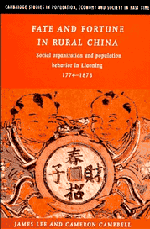Book contents
- Frontmatter
- Contents
- List of figures
- List of maps
- List of tables
- Acknowledgements
- PART 1 DAOYI VILLAGE
- PART 2 THE LIAONING DEMOGRAPHIC SYSTEM
- PART 3 HOUSEHOLD ORGANIZATION AND POPULATION BEHAVIOR
- PART 4 BANNER ORGANIZATION AND POPULATION BEHAVIOR
- EPILOGUE: PROSPECTS, IMPLICATIONS, AND COMPARISONS
- Appendices
- Glossary
- References
- Index
- Cambridge Studies in Population, Economy and Society in Past Time
EPILOGUE: PROSPECTS, IMPLICATIONS, AND COMPARISONS
Published online by Cambridge University Press: 20 October 2009
- Frontmatter
- Contents
- List of figures
- List of maps
- List of tables
- Acknowledgements
- PART 1 DAOYI VILLAGE
- PART 2 THE LIAONING DEMOGRAPHIC SYSTEM
- PART 3 HOUSEHOLD ORGANIZATION AND POPULATION BEHAVIOR
- PART 4 BANNER ORGANIZATION AND POPULATION BEHAVIOR
- EPILOGUE: PROSPECTS, IMPLICATIONS, AND COMPARISONS
- Appendices
- Glossary
- References
- Index
- Cambridge Studies in Population, Economy and Society in Past Time
Summary
There is no such thing as a representative community. This is as true for China as elsewhere. Nevertheless, Daoyi was hardly unique. There were many similar military farming communities in late imperial China. Military state lands called qidi under the Eight Banner Armies, or tuntian under the Green Standard Armies, represent 5–10 percent of all registered land during the eighteenth century. Some of these lands were regular banner estates, similar to Daoyi, or military estates under similar military administration. Others were imperial or noble estates under imperial household or noble household control. While there are no aggregate population statistics for these state farm populations in Liaoning or for that matter any other province, their national proportions were probably roughly similar to that of the registered cultivated acreage, that is, 5–15 million people in the middle of the eighteenth century, i.e. somewhere between the national populations of England and France.
Prospects
Like the men and women of Daoyi, the social organization and population behavior of these state farm populations can be reconstructed in great detail. Thousands of household registers, similar to the twenty-five that provide the bulk of the data for this book, have been discovered in the historical archives of Beijing, Heilongjiang, Inner Mongolia, Jilin, and Liaoning (Finegan and Telford 1988). Others may survive elsewhere as well. In Liaoning alone, these registers record some 5 million observations for approximately 1 million individuals who lived during the eighteenth and nineteenth centuries. Other archival materials record a variety of other information on the institutional, legal, and social history of many of these communities, as do a number of elaborate lineage genealogies.
- Type
- Chapter
- Information
- Fate and Fortune in Rural ChinaSocial Organization and Population Behavior in Liaoning 1774–1873, pp. 215 - 222Publisher: Cambridge University PressPrint publication year: 1997

